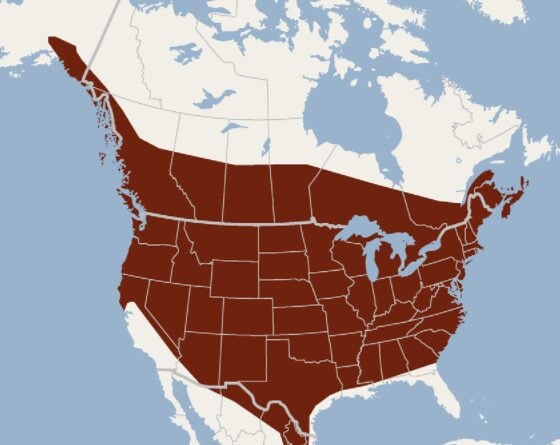4 Types of Bats In Alaska! (ID GUIDE)
How can anyone in Alaska think that bats are scary?

Despite what you see in the movies, these fascinating flying mammals wouldn’t hurt a fly! Well, technically, they would hurt a fly, or a mosquito, or a moth. But other than that, bats are harmless. 🙂
It’s hard to believe the diversity and amount of bat species that can be found in Alaska! But, unfortunately, when you see a bat, it’s typically pretty difficult to determine which kind it is. These nocturnal creatures fly incredibly fast and are only active at night.
4 kinds of bats in Alaska:
#1. Silver-haired Bat
- Lasionycteris noctivagans

- Medium-sized with a flathead. The upper part of the tail is covered in thick fur.
- Mostly black all over with white tips on hairs, with a wingspan of approximately 11.5 inches (29 cm).
This species is known to fly more slowly than other bats in Alaska.
Look for Silver-haired Bats in forests inside tree cavities or bark crevices. They’ve also been known to seek shelter in outbuildings.
Silver-haired Bat Range Map
Silver-haired Bats hunt for soft-bodied insects, such as moths. Interestingly, they also eat a lot of spiders. They accomplish this feat by foraging low to the ground to find food, unlike many other bats.
#2. Little Brown Bat
- Myotis lucifugus

- Glossy brown fur on the body. Wings are hairless and black, with a wingspan of approximately 10 inches (25 cm).
- Despite its name, it has no connection to the Big Brown Bat.
Look for the Little Brown Bat roosting in Alaska in sheltered places such as human structures, woodpiles, tree hollows, and occasionally caves.
You can even attract Little Brown Bats to your yard! Many people put up bat houses to attract them to their property to control pests like mosquitos or insects that harm crops.
- RELATED: The 7 BEST Bat Houses For Sale! (All price ranges)
Little Brown Bat Range Map

Distribution of all little brown bat subspecies: M. l. lucifugus (red), M. l. pernox (green), M. l. alascensis (blue), M. l. carissima (yellow), M. l. relictus (gray)
Little Brown Bats only have a few natural predators, like owls or raccoons. Unfortunately, most of their mortality is caused by parasites or White-nose syndrome.
White-nose syndrome is a fungal disease that grows around the bats’ mouths, ears, and wings. This illness is spread during hibernation and is responsible for the loss of over one million Little Brown Bats between 2006 and 2011. As of 2018, the Little Brown Bat is an endangered species.
#3. Long-legged Bat
- Myotis Volans

- Fur color can vary from light or dark brown to reddish-brown. Tips of their can actually touch their nostrils. Wingspan is approximately 9 inches (23 cm).
- Unlike other bats, they have fur on the underside of their wings from elbows to knees.
- They got their name from having a longer tibia bone when compared to other bats.
The Long-legged Bat has unique feet that allow them to hang upside down for an extended time without wasting energy. This feat is accomplished by locking their toes in place. In addition, special cavities in their head prevent blood from going to their brain.
Long-legged Bat Range Map

These bats prefer to roost in the barks of trees and crevices in rocks, caves, and buildings. They like to spend time in higher elevations in the summer, and then in the winter, they will come down and live and hibernate in caves and mines.
Like other bats in Alaska, they primarily eat mainly moths using echolocation. However, the Long-legged Bat differs because they get a head start over other bats! They do this by leaving their roost early, foraging before sunset, and then eating throughout the entire night.
Check out this video to see how the Long-legged Bat uses echolocation to catch moths!

#4. California Myotis
- Myotis californicus

- Smaller bat with brown fur and black ears, wings, legs, and feet.
- The forehead is sloping, and the tail is short and does not extend past the membrane.
- The wingspan is 9 to 10 inches (23-25 cm)
Look for this bat in Alaska in forested habitats in lower elevations. They roost in rock crevices, dead or hollowed trees, under loose bark, and buildings in the summer. In winter, you’ll find them in caves or mines.
California Myotis Range Map
The females and males roost in separate places during the summer but then reunite during hibernation.
The California Myotis flies slower and more erratic as it hunts near the edges of the forest or over water.
Do you need additional help identifying bats in Alaska?
If so, this field guide should be able to help you.
Which of these bats have you seen before in Alaska?
Leave a comment below!
Check out my other guides about animals in Alaska!
-
Owl Species That Live in Alaska!
-
Common Spiders Found in Alaska! (Includes venomous species)



